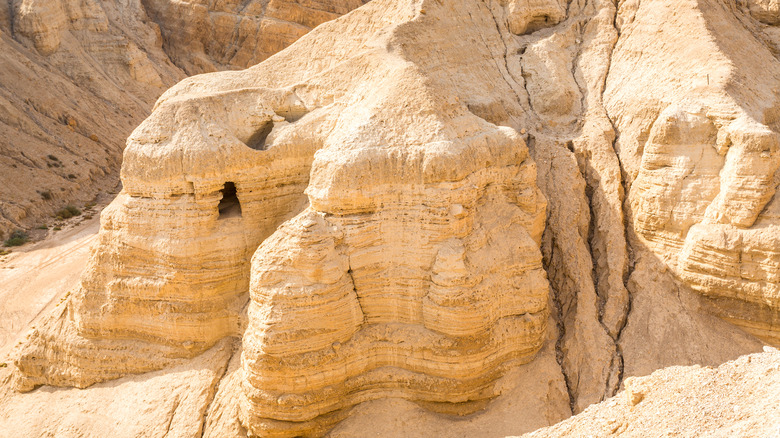What You Didn't Know About The Largest Dead Sea Scroll
For each of the globe's revered, renowned "holy books," there are droves of lesser known, non-canonical texts milling around in labs and museums. The Apocrypha, the Pseudepigrapha, the Aggaddah (or Haggaddah), books like the Gospel of Judas found in the 1970s, the 13th-century Zohar of Kabbalah, an ancient Jewish, rabbinical, set of nigh-heretical writings related to mystical Gnostic beliefs... the list goes on and on.
In comparison to these texts, the content of the Dead Sea Scrolls, one of the more famous of such writings, is practically tame. While texts like the Pseudepigrapha challenge conventional beliefs by portraying, for instance, King Solomon as a magic ring-wearing wizard and interrogator of physical demons, the Dead Sea Scrolls are basically an old version of the Old Testament. As Smithsonian Magazine states, they contain bits of Old Testament books, in Hebrew, and include "previously unknown hymns, prayers, commentaries, mystical formulas and the earliest version of the Ten Commandments."
The Dead Sea Scrolls date back to about 200 BCE, when the Jewish Kingdom of Judah had been transfigured into the Roman province of Judea. The scrolls were likely hurriedly stuffed into a set of caves in the Jewish community at Qumran along the west bank of the Dead Sea, directly east of Jerusalem, during one of Jewry's more conspicuous revolts against the Romans, from 66 to 70 CE, explained on the PBS. When they were first discovered and excavated, starting in 1947, one scroll stood out above the rest: the long, involved "Temple Scroll."
A long, well-preserved copy of an earlier text
The Dead Sea Scrolls aren't a single, bound book or anything. As the name implies, they're composed of multiple manuscripts found across 11 caves. The "Temple Scroll," likely found in 1956, is the longest manuscript, at a bit over 8 meters long (~26.5 feet). It's composed of 18 pieces of parchment each having three or four columns, per the Israel Museum.
In comparison to some other parts of the Dead Sea Scrolls, describable as tattered fragments, the Temple Scroll is fairly well-preserved, especially the inner portion of the scroll — the latter half of the manuscript — that would have been better protected from the elements. The Temple Scroll it's also the thinnest of the Dead Sea Scrolls, in terms of materials (some kind of animal skin), at one-tenth of a millimeter. There were also two other, less complete copies found at the site. While the Temple Scroll itself is one of the newer of the Dead Sea Scrolls, likely written in the early first century BCE, scholars believe that its text was copied from an earlier piece of writing dating back to the second half of the second century BCE (about 40-50 years earlier).
As for the Temple Scroll's contents, they're a detailed combination of prescriptive and descriptive. It's important to note, though, as Blue Letter Bible tells us, that the Jewish community at Qumran was likely a fringe, monastic community whose beliefs might not have been consistent with accepted orthodoxy.
Precise guidelines for rituals and temple construction
If anyone has read the Hebrew Scriptures, what Christians call the Old Testament, one thing is very clear: God definitely loved rules. Many of them relate to cleanliness and agriculture, which of course makes sense for thousands-of-years-old, close-knit, Middle-eastern tribal bands of farmers heavily reliant on regional climate, rainfall, hygiene, and the like.
To be specific, the Temple Scroll is a kind of consolidation of parts of Exodus, Leviticus, Numbers, and Deuteronomy to make a mega-book of laws, like a guide, for everything Temple-related. And for the record, we're talking about the First Temple — Solomon's Temple (yes, that guy again) — that stood from about 1200 BCE to 586 BCE before it was destroyed by King Nebuchadnezzar of Babylon, as the Jewish Virtual Library recounts. The text includes instructions from God to Moses, which occurred prior to the building of any temple.
As for the instructions themselves, they're way too persnickety to cover in detail in this article. In general, as the Religious Studies Center at Brigham Young University says, they contain exact architectural blueprints for the temple and its tabernacles, one for each of the 12 tribes of Israel, including slaughterhouses, stairwells, towers, courtyards, attics and roofs, "gold-plated cubicles for depositing the priestly garments," and so on. There are also prohibitions against sex — "a ritually defiling act" — before beholding any religious rite, and instructions that the nearest toilet be no closer than 3,000 cubits (one mile) away.


